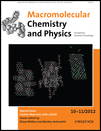
MACROMOLECULAR CHEMISTRY AND PHYSICS
Scope & Guideline
Fueling the Evolution of Macromolecular Knowledge
Introduction
Aims and Scopes
- Polymer Synthesis and Characterization:
The journal emphasizes the development of new synthetic methodologies for polymers, including radical polymerization, controlled/living polymerization techniques, and the use of innovative catalysts. Characterization techniques such as NMR, GPC, and rheology are frequently discussed to elucidate the structure-property relationships of synthesized polymers. - Functional and Smart Polymers:
There is a strong focus on the design and application of functional polymers that respond to external stimuli such as temperature, pH, light, and other environmental factors. This includes the development of smart hydrogels, shape memory polymers, and self-healing materials that have potential applications in biomedical, electronic, and environmental fields. - Biomaterials and Green Polymers:
Research on biodegradable and biocompatible polymers is a significant area of interest, reflecting the growing need for sustainable materials. The journal publishes studies on natural polymers, biopolymers, and the development of green polymerization methods to minimize environmental impacts. - Nanocomposites and Hybrid Materials:
The journal explores the integration of nanomaterials into polymer matrices to enhance mechanical, thermal, and electrical properties. This includes the study of nanocomposites, hybrid materials, and their applications in various fields such as electronics, energy storage, and coatings. - Polymer Physics and Theoretical Studies:
The journal also addresses the physical principles governing polymer behavior, including molecular dynamics, phase transitions, and mechanical properties. Theoretical models and simulations play a crucial role in understanding the complex behavior of polymers at the molecular level.
Trending and Emerging
- Sustainable and Biodegradable Polymers:
There is a growing emphasis on the development of sustainable and biodegradable polymers, driven by environmental concerns. Research exploring biopolymers, their synthesis, and their applications in reducing plastic waste is becoming increasingly prominent. - Advanced Functional Polymers:
Emerging research on advanced functional polymers that incorporate multiple functionalities, such as self-healing, shape memory, and stimuli responsiveness, is trending. These materials are being designed for specific applications in medicine, electronics, and other high-tech fields. - Nanotechnology in Polymer Science:
The integration of nanotechnology into polymer science is on the rise, with studies focusing on the synthesis and application of nanocomposites, hybrid materials, and nanostructured polymers, which enhance performance in various applications. - Polymer-Based Energy Storage Solutions:
Research related to polymer electrolytes for batteries and supercapacitors is gaining momentum, reflecting the demand for energy-efficient and sustainable energy storage solutions. - Machine Learning and Computational Polymer Science:
The application of machine learning and computational methods in predicting polymer properties and behavior is an emerging theme, showcasing the intersection of data science and polymer research.
Declining or Waning
- Conventional Polymerization Methods:
There has been a noticeable decrease in studies focused solely on conventional polymerization methods without the integration of novel techniques or materials. Researchers appear to be moving towards more innovative and advanced methodologies. - Basic Polymer Chemistry:
While foundational studies in polymer chemistry are still relevant, there has been a waning interest in purely theoretical or basic chemical studies without application or relevance to current technological challenges. - Rigid Polymer Systems:
Research focused on rigid, non-functional polymer systems has seen a decline as interest shifts towards more versatile, functional, and adaptive polymeric materials that can meet the demands of modern applications.
Similar Journals

POLYMER SCIENCE SERIES B
Cultivating Expertise in Advanced Polymer MaterialsPOLYMER SCIENCE SERIES B is a distinguished journal published by MAIK NAUKA/INTERPERIODICA/SPRINGER, dedicated to advancing knowledge in the fields of ceramics and composites, materials chemistry, and polymers and plastics. The journal, identifiable by its ISSN 1560-0904 and E-ISSN 1555-6123, spans a significant timeline from 1996 to 2024, reflecting its commitment to preserving and disseminating cutting-edge research in polymer science. With its current ranking in the Q3 category across relevant fields, it supports scholars and professionals in enhancing their understanding and application of polymeric materials. While it operates on a non-open access basis, the journal is pivotal for researchers seeking in-depth analysis and peer-reviewed studies. Located in the heart of the United States at 233 Spring St, New York, NY 10013-1578, POLYMER SCIENCE SERIES B serves as an essential resource for committed researchers, professionals, and students aiming to push the boundaries of polymer science.
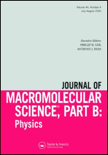
Journal of Macromolecular Science Part B-Physics
Cultivating Discoveries in Polymer PhysicsThe Journal of Macromolecular Science Part B-Physics, published by Taylor & Francis Inc, is a critical platform for advancing knowledge in the realms of macromolecular science and interdisciplinary research at the intersection of physics, chemistry, and materials science. With an ISSN of 0022-2348 and E-ISSN of 1525-609X, this journal has been a cornerstone of scientific discourse since its inception in 1967, continuing to offer invaluable insights and innovative findings through to 2024. The journal holds a Q3 ranking across several disciplines, including Chemistry (miscellaneous), Condensed Matter Physics, Materials Chemistry, and Polymers and Plastics, reflecting its relevance and importance within the scientific community. Although it does not support open access, the rigor of its peer-review process ensures that published articles meet the highest standards of scientific excellence. Researchers, professionals, and students alike will find the journal an essential resource for the latest trends and discoveries in macromolecular physics, aiding in both academic pursuits and practical applications in material design and analysis.

POLYMER SCIENCE SERIES A
Harnessing Expertise in Materials ChemistryPOLYMER SCIENCE SERIES A is a distinguished journal dedicated to the field of polymer science, with a focus on advancing knowledge in materials chemistry and polymers and plastics. Published by MAIK NAUKA/INTERPERIODICA/SPRINGER, this journal provides a platform for researchers and practitioners to disseminate their findings and innovations. With an ISSN of 0965-545X and an E-ISSN of 1555-6107, it is widely accessible to the academic community. Although currently non-open access, the journal has maintained its significance since its inception in 1991, boasting an evolving emphasis on contemporary issues in polymer science up to 2024. Ranked in the Q3 category for both Materials Chemistry and Polymers and Plastics in 2023, POLYMER SCIENCE SERIES A plays a crucial role in the broader academic landscape, particularly for those committed to understanding and enhancing polymer materials. The journal’s reputation is solidified by its Scopus rankings, where it addresses critical advancements and fosters collaborative research opportunities within the community. We invite researchers, professionals, and students to explore the valuable insights published within these pages.
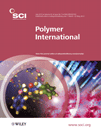
POLYMER INTERNATIONAL
Exploring the Frontiers of Material ChemistryPOLYMER INTERNATIONAL is a leading journal in the field of polymer science, published by Wiley, one of the most esteemed scholarly publishers. With an ISSN of 0959-8103 and an E-ISSN of 1097-0126, this journal has been a pivotal platform for researchers since its inception in 1991, now extending its coverage until 2024. The journal boasts a commendable standing in various scientific domains, achieving a Q2 quartile ranking in Materials Chemistry, Organic Chemistry, and Polymers and Plastics as of 2023. Additionally, it holds impressive Scopus ranks, including Rank #47 in Organic Chemistry and Rank #40 in Polymers and Plastics, placing it within the top percentiles of its categories. Researchers, professionals, and students alike can benefit from its rich array of articles that contribute to the understanding and advancement of polymer technology and materials science. Although not an open access journal, POLYMER INTERNATIONAL remains crucial for disseminating high-quality research that drives innovation and development within the field.

JOURNAL OF POLYMER SCIENCE
Elevating Polymer Science: Bridging Research and Real-World ApplicationsJOURNAL OF POLYMER SCIENCE, published by WILEY, is a premier, open-access journal dedicated to advancing the field of polymer science and its applications. With an ISSN of 2642-4150, it offers a platform for high-quality research and innovative ideas, contributing significantly to the understanding of polymaterials and their functionalities. The journal is recognized for its exceptional impact within various categories, consistently achieving Q1 rankings in Materials Chemistry, Physical and Theoretical Chemistry, and Polymers and Plastics, demonstrating its influential presence in the academic community. As of 2023, it holds a distinguished position in Scopus rankings, underscoring its relevance and rigorous peer-review process. By facilitating open access to vital research findings, the JOURNAL OF POLYMER SCIENCE plays a crucial role in fostering collaboration and knowledge transfer among researchers, professionals, and students, paving the way for innovative developments in polymer applications and materials science.
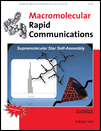
MACROMOLECULAR RAPID COMMUNICATIONS
Pioneering Rapid Advances in Materials ChemistryMACROMOLECULAR RAPID COMMUNICATIONS, published by WILEY-V C H VERLAG GMBH in Germany, is an esteemed journal dedicated to the rapid dissemination of high-quality research in the fields of materials chemistry, organic chemistry, and polymers and plastics. With a remarkable 2023 impact factor securing its place in the prestigious Q1 category across three key disciplines, the journal ranks impressively within the top quartiles of the Scopus metrics, standing at 36th in organic chemistry and 35th in polymers and plastics. Although the journal does not offer open access options, its informative depth and innovative research make it an invaluable resource for researchers, professionals, and students seeking to stay abreast of the latest developments in macromolecular science. Covering a broad spectrum of topics from fundamental research to applications, MACROMOLECULAR RAPID COMMUNICATIONS aims to foster collaboration and inspire further advancements within the scientific community.
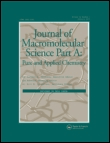
Journal of Macromolecular Science Part A-Pure and Applied Chemistry
Advancing the Frontiers of Macromolecular ScienceWelcome to the Journal of Macromolecular Science Part A - Pure and Applied Chemistry, a distinguished publication dedicated to advancing the understanding of macromolecular science, encompassing critical areas such as polymers, materials chemistry, and composites. Published by Taylor & Francis Inc, this journal has firmly established its place within the scientific community, evident from its ranking in the Q2 and Q3 quartiles across various categories in the latest assessments, including Polymers and Plastics as well as Ceramics and Composites. With a commitment to providing high-quality peer-reviewed content, the journal aims to facilitate knowledge exchange and innovation among researchers and practitioners from around the globe. The absence of open access underscores the journal's commitment to maintaining rigorous editorial standards while remaining accessible to its readership. As the journal converges through valuable research contributions from 1992 to 2024, it continues to be a pivotal resource for professionals and students seeking to explore the latest advancements and applications in the field of macromolecular science.

JOURNAL OF POLYMER RESEARCH
Exploring the Dynamics of Polymer TechnologyJOURNAL OF POLYMER RESEARCH is a leading peer-reviewed journal published by SPRINGER, specializing in the dynamic fields of polymer science, materials chemistry, and organic chemistry. Operating since 1994, this esteemed journal has consistently delivered high-quality research articles that illuminate the latest advancements and innovations in polymer technology. With an increasing impact factor and placed in the Q2 category for both Materials Chemistry and Polymers and Plastics, it stands as a valuable resource for researchers, professionals, and students seeking cutting-edge knowledge in these areas. The journal is indexed in Scopus, highlighting its significance in the academic community, with notable rankings in Materials Science and Organic Chemistry. While it does not currently offer open access options, the meticulous selection of research and thorough peer-review process ensures each article's contribution to the field is both robust and impactful. Researchers aiming to expand their understanding and engage with pioneering studies will find JOURNAL OF POLYMER RESEARCH an indispensable platform.

Polymer Chemistry
Leading the Charge in Polymer Research ExcellencePolymer Chemistry is a premier peer-reviewed journal published by the Royal Society of Chemistry, focusing on cutting-edge research and developments in the field of polymer science. With its ISSN 1759-9954 and E-ISSN 1759-9962, this journal has established a significant impact within the academic community, as evidenced by its impressive Q1 ranking in areas such as Biomedical Engineering, Organic Chemistry, and Polymers and Plastics. Over its convergence period from 2010 to 2024, Polymer Chemistry has become an essential resource for researchers, professionals, and students, showcasing innovative studies that advance the understanding of polymer behavior and applications. The journal does not currently offer open access, allowing for a traditional but rigorous peer-review process ensuring high-quality publications. For those engaged in the rapidly evolving disciplines of biochemistry and bioengineering, Polymer Chemistry serves as a vital platform for disseminating influential findings and fostering interdisciplinary collaboration in a global context.

INTERNATIONAL JOURNAL OF POLYMER ANALYSIS AND CHARACTERIZATION
Pioneering research in analytical chemistry and polymers.International Journal of Polymer Analysis and Characterization is a distinguished scholarly publication dedicated to the field of polymer science, with a focus on innovative methodologies and significant advances in the analysis and characterization of polymeric materials. Published by Taylor & Francis Ltd in the United Kingdom, this journal serves as a vital resource for researchers, professionals, and students deeply engaged in Analytical Chemistry, Chemical Engineering, and Polymer Science. With a convergence spanning from 1995 to 2024, it holds a Q3 ranking in the 2023 category quartiles for its valuable contributions to the fields of Analytical Chemistry, Chemical Engineering, and Polymers and Plastics. Despite being a non-open access publication, its rigorous peer-review process and comprehensive coverage of current trends ensure that the journal remains a crucial platform for disseminating impactful research. The journal is indexed in various databases, underscoring its relevance and quality in the academic community. Exploratory studies and articles that push the boundaries of polymer analysis find a welcoming home within these pages, making it an essential read for those aiming to stay at the forefront of polymer research.